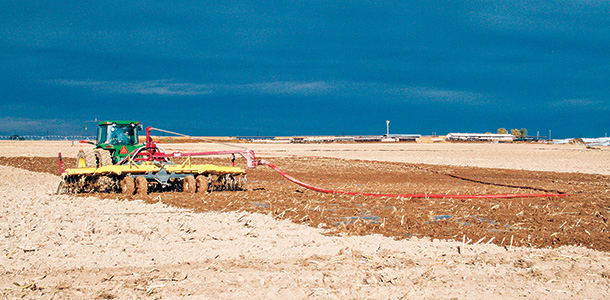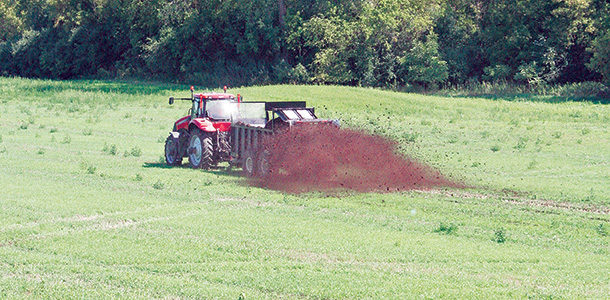The right mix of product treatment and some simple farm management techniques can greatly enhance dairy producers’ ability to increase nutrient efficiency in manure applied on land and used by growing crops.
Andy Mroczek of Mroczek Farms in Honeoye Falls, New York, says when considering how to increase nutrient efficiency in manure applied on land, he says it all really begins with the proper mindset.
“Dairy producers need to get their minds wrapped around the idea that you cannot treat manure like a waste product.
Treat it like a fertilizer because it does have value,” Mroczek, a dairy and grain producer, says. “So one of the first things you should do if you have manure is understand the value of the waste product you are handling – it does have value.”
Depending on how you’re handling the manure – by the ton or gallon and whether in a solid or liquid form – can help determine what fertilizer value it would have, according to Mroczek. “With this information, you can put a value on it,” he says.
He says the key is to maximize the extraction of what is valuable in the manure. Mroczek advises having the manure incorporated into a solid, so that it’s not going to volatize or leak.
“We use disc incorporators on spreaders as soon as spreaders put it down,” he says. According to him, this saves volatization and runoff, and helps lock nutrients into the soil so it won’t go anywhere.
At Mroczek Farms, Mroczek says they are handling liquid cow manure from milking herds. “Every time we take a spreader load out of 6,000 gallons, it’s approximately $185 to $200 worth of fertilizer value,” he says.
He says the farms also add stabilizer, which helps stabilize the nitrogen portion of manure. This product in particular, he says, also stabilizes phosphorus.
“One of my take-home messages is that if you use a stabilization product, you can achieve, though not guaranteed, a two-to-one return for every dollar you invest, meaning you get $2 back for every dollar spent,” he says.
To keep track of results, his farms undergo soil testing on a three-year rotation, meaning a third is tested each year by an outside tester, Western New York Crop Service. They handle the farm’s soil sampling and offer fertilizer and chemical recommendations, essentially serving as consultants.
Another dairy producer, Leroy Schafer, of Westphalia, Michigan, says the goal with gaining efficiency of nutrients in the manure is to find any product that helps control nitrogen and phosphorus. He has been using a stabilizer product for two years.
 “In our case, we try to work the treatment into the soil within 12 to 36 hours. You want to incorporate it as soon as you can. This saves the nitrogen from volatizing, or changing forms as it is released into the air,” Schafer says. “You don’t want to lose that nitrogen.
“In our case, we try to work the treatment into the soil within 12 to 36 hours. You want to incorporate it as soon as you can. This saves the nitrogen from volatizing, or changing forms as it is released into the air,” Schafer says. “You don’t want to lose that nitrogen.
“So far, the return on the product is well worth it. The first year we used it, we did a yield test and saw 15 bushels more per acre. Obviously, we can’t guarantee those results every year, with weather changes and timing of everything,” he says.
Using the right product for your farm can help producers realize differences in pit cleanout, hauling efficiencies and stabilization of nitrogen and phosphorus in soil, according to Amanda Hassenger, who works for Harveys Milling in central Michigan.
“A healthier plant means a higher yield overall,” Hassenger says. “And because you are stabilizing from manure, you don’t have to use as much commercial fertilizer. So it saves money in many ways.”
For those who have liquid manure pits, foaming can be a problem, leading to the ability to only haul three-quarters-full loads. When using an appropriate manure treatment, you can virtually eliminate foaming, according to Hassenger. This means producers can add more to each tanker load.
She says when looking for the best manure treatment product for your farm, a goal should be to look for ways to stabilize nutrients in the manure and generate consistent results year-to-year.
Hassenger mentions some simple tips that, though likely common knowledge to many producers, can serve as helpful reminders:
1. Spread manure when no severe weather is coming up.
2 . Incorporate it as quickly as possible.
3. Injection is one of the best ways to spread manure. “If it’s directly injected into the ground, it doesn’t get a chance to volatize and lose nitrogen that you have. Phosphorus is a hard one to save other than using (a stabilizer product) because otherwise it gets tied up in the soil,” Hassenger says.
4. Consider using a nutrient management computer program, which offers an effective way to manage records as far as manure management and crop management.
“Such a program can help you look at what you’ve done in the past and make a plan for what you do in the future. Optimum record-keeping is always a great way to increase efficiency,” she says. PD
Stephanie Skernivitz is a freelance writer from Berea, Ohio.
PHOTOS
“If it’s directly injected into the ground, it doesn’t get a chance to volatize and lose nitrogen that you have. Phosphorus is a hard one to save other than using (a stabilizer product) because otherwise it gets tied up in the soil.” Photos by PD staff.






